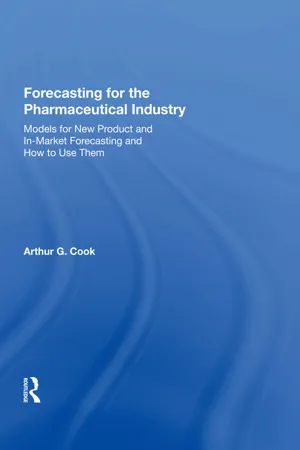
Forecasting for the Pharmaceutical Industry
Models for New Product and In-Market Forecasting and How to Use Them
- 160 pages
- English
- ePUB (mobile friendly)
- Available on iOS & Android
Forecasting for the Pharmaceutical Industry
Models for New Product and In-Market Forecasting and How to Use Them
About this book
In virtually every decision, a pharmaceutical executive considers some type of forecast. This process of predicting the future is crucial to many aspects of the company - from next month's production schedule, to market estimates for drugs in the next decade. The pharmaceutical forecaster needs to strike a delicate balance between over-engineering the forecast - including rafts of data and complex 'black box' equations that few stakeholders understand and even fewer buy into - and an overly simplistic approach that relies too heavily on anecdotal information and opinion. Art Cook's highly pragmatic guide explains the basis of a successful balanced forecast for products in development as well as currently marketed products. The author explores the pharmaceutical forecasting process; the varied tools and methods for new product and in-market forecasting; how they can be used to communicate market dynamics to the various stakeholders; and the strengths and weaknesses of different forecast approaches. The text is liberally illustrated with tables, diagrams and examples. The final extended case study provides the reader with an opportunity to test out their knowledge. Forecasting for the Pharmaceutical Industry is a definitive guide for forecasters as well as the multitude of decision makers and executives who rely on forecasts in their decision making.
Frequently asked questions
- Essential is ideal for learners and professionals who enjoy exploring a wide range of subjects. Access the Essential Library with 800,000+ trusted titles and best-sellers across business, personal growth, and the humanities. Includes unlimited reading time and Standard Read Aloud voice.
- Complete: Perfect for advanced learners and researchers needing full, unrestricted access. Unlock 1.4M+ books across hundreds of subjects, including academic and specialized titles. The Complete Plan also includes advanced features like Premium Read Aloud and Research Assistant.
Please note we cannot support devices running on iOS 13 and Android 7 or earlier. Learn more about using the app.
Information
Chapter 1
The Past and the Present
The Inaccuracy of Forecasting
| Company | Leaders | Laggards |
| McDonald’s | Big Mac and fries | Seaweed burgers |
| Sony | Walkman | Beta-format VCRs |
| Kodak | 35mm photography | Instant photography |
| Federal Express | Overnight mail | ZapMail |
| Coke | Classic Coke | New Coke |
Forecasting in the Pharmaceutical Industry
| Peak sales (millions of US dollars) | |||
| Company | Drug name | Estimated | Actual |
| | |||
| Merck | Blocarden | 500–1000 | 15 |
| A. H. Robbins | Pondamin | 300 | 3 |
| Sterling | Amrinone (oral) | 500 | 0 |
| SmithKline | Monocid | 100 | 20 |
Table of contents
- Cover
- Half Title
- Title
- Copyright
- Contents
- List of Figures
- List of Tables
- List of Abbreviations
- Acknowledgements
- Foreword
- 1 THE PAST AND THE PRESENT
- 2 THE FORECASTING PROCESS
- 3 NEW PRODUCT FORECASTING
- 4 IN-MARKET PRODUCT FORECASTING
- 5 THOUGHTS FOR THE FUTURE
- 6 PHARMACO – A FORECASTING CASE STUDY
- Appendix: Forecast Techniques
- References and Further Reading
- Index